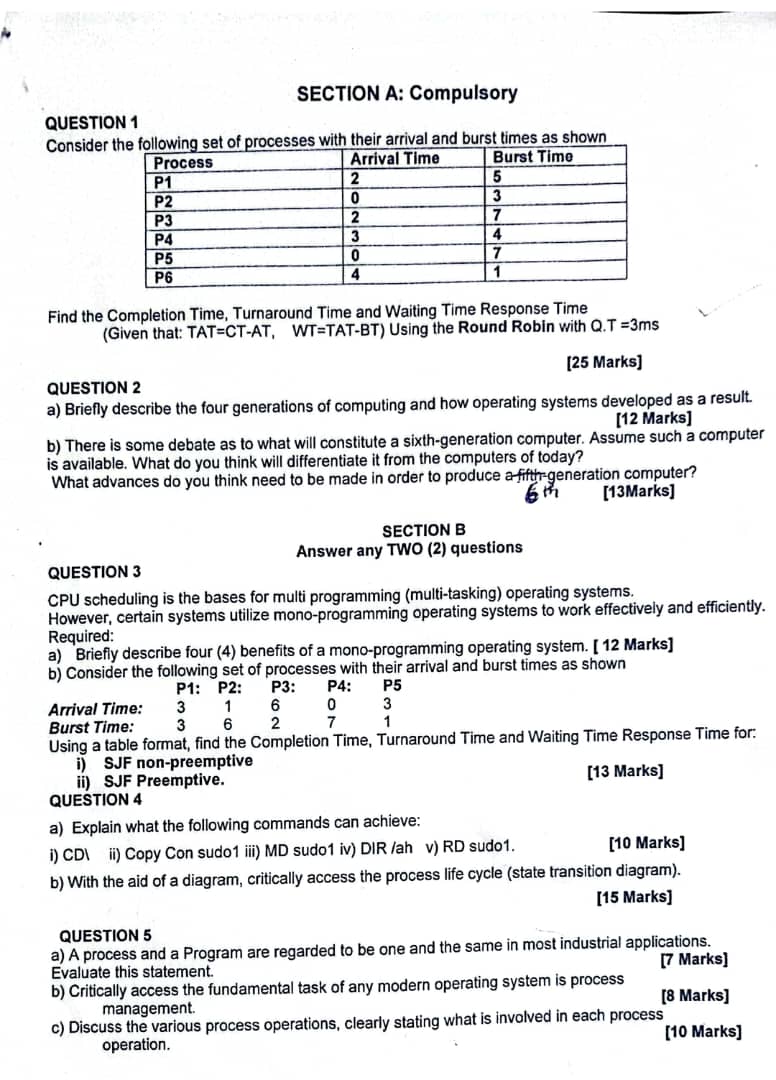Consider the following set of processes with their arrival and burst times. Find the Completion Time, Turnaround Time and Waiting Time Response Time using the Round Robin with Q.T... Consider the following set of processes with their arrival and burst times. Find the Completion Time, Turnaround Time and Waiting Time Response Time using the Round Robin with Q.T = 3ms. Briefly describe the four generations of computing and how operating systems developed as a result. Discuss the sixth-generation computer expectations.

Understand the Problem
The question requires calculating the Completion Time, Turnaround Time, and Waiting Time for a set of processes using the Round Robin scheduling method with a time quantum of 3 ms. Additionally, it asks for a brief description of computing generations and their evolution, along with a discussion on anticipated advancements for future computer generations.
Answer
Completion Time (CT): P1=14, P2=3, P3=10, P4=14, P5=21, P6=20; Turnaround Time (TAT): P1=12, P2=3, P3=10, P4=11, P5=21, P6=16; Waiting Time (WT): P1=7, P2=0, P3=3, P4=7, P5=14, P6=15.
Answer for screen readers
-
Completion Time (CT):
- P1: 14
- P2: 3
- P3: 10
- P4: 14
- P5: 21
- P6: 20
-
Turnaround Time (TAT):
- P1: 12
- P2: 3
- P3: 10
- P4: 11
- P5: 21
- P6: 16
-
Waiting Time (WT):
- P1: 7
- P2: 0
- P3: 3
- P4: 7
- P5: 14
- P6: 15
Steps to Solve
-
Set up the processes List the processes with their arrival times and burst times.
- P1: Arrival Time = 2, Burst Time = 5
- P2: Arrival Time = 0, Burst Time = 3
- P3: Arrival Time = 0, Burst Time = 7
- P4: Arrival Time = 3, Burst Time = 4
- P5: Arrival Time = 0, Burst Time = 7
- P6: Arrival Time = 4, Burst Time = 1
-
Initialize time tracking We'll keep track of the current time and the remaining burst time for each process. Initialize:
- Current Time (CT) = 0
- Remaining Time (RT) for each process equal to their Burst Time.
-
Create a queue for processing Use a queue to manage processes as they arrive. The time quantum (QT) is 3 ms.
-
Process scheduling using Round Robin Iterate through the processes:
- For each process in the queue, if its arrival time is less than or equal to the current time:
- Execute it for a maximum of 3 ms or until its remaining time is finished.
- Update current time from CT by adding the time used.
- Update the remaining time (RT).
- If RT > 0, re-add it to the queue.
- If RT = 0, calculate Completion Time (CT) and update Turnaround Time (TAT) and Waiting Time (WT).
- For each process in the queue, if its arrival time is less than or equal to the current time:
-
Calculate Completion Time, Turnaround Time and Waiting Time
- Completion Time (CT) = current time when the process is finished.
- Turnaround Time (TAT) = CT - Arrival Time.
- Waiting Time (WT) = TAT - Burst Time.
-
Compile results Gather the completion, turnaround, and waiting times for all processes into a table format for clarity.
-
Completion Time (CT):
- P1: 14
- P2: 3
- P3: 10
- P4: 14
- P5: 21
- P6: 20
-
Turnaround Time (TAT):
- P1: 12
- P2: 3
- P3: 10
- P4: 11
- P5: 21
- P6: 16
-
Waiting Time (WT):
- P1: 7
- P2: 0
- P3: 3
- P4: 7
- P5: 14
- P6: 15
More Information
In Round Robin scheduling, each process gets a fixed time to execute, which makes it suitable for time-sharing systems. Efficient process management is vital in operating systems to ensure fairness and responsiveness.
Tips
- Forgetting to keep track of processes that arrive while others are executing in Round Robin can lead to inaccuracies.
- Miscalculating times by not properly considering remaining times after each time quantum.
AI-generated content may contain errors. Please verify critical information